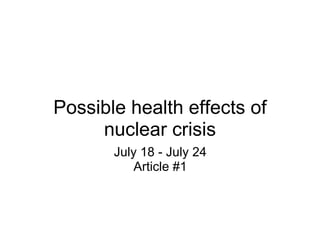July 18 july_24_possible_health_effects_of_nu
- 1. Possible health effects of nuclear crisis July 18 - July 24 Article #1
- 2. ????????????????????? Introduction Fukushima NO.1 power plant don't avert a meltdown.unclear authorities have reported that spikes of radiation have escaped from the facility at levels that can be dangerous to human health.so many people within 20 km of the plant escape the area. we look at the potential radiation effect human health.
- 3. what are kind of radiation damaging for people? radiation have two types of radiation , non-ionizing and ionizing Non-ionizing radiation includes infrared radiation,radio waves, cellphone and the radiation we use to cook food in a microwave.non-ionizing radiation don't have hazardous effect . ? But ionizing is much more dangerous? ionizing radiation does break chemical bonds and thus does cause cancer.? ???
- 4. How effect when human is exposed to ionizing radiation. The damaging depends on how long? you are exposed.The initial symptoms are identical to those suffered by a person undergoing radiation therapy for cancer. the first signs include nausea and fatigue, then vomiting. After that comes hair comes hair loss and diarrhea. And heavier exposure is generally destruction of the intestinal lining and worse diarrhea and dehydration, then central nervous system damage.After that comes loss of consciousness and death.
- 5. How does radiation from nuclear plants compare with a nuclear bomb? ? A nuclear explosion produces two types of radiation that have lethal effect.That blast itself produces X - rays and gamma rays that irradiate anyone near the site, usually with a lethal or near-lethal dose of radiation.the radiation kill people directly or aggravates other injuries suffered in the blast. ? clouds of radioactive ash that includes cesium -137,iodine-131, radioactive strontium and a host of other long lived byproducts of the explosion.This material can collect on skin and clothing, where it can emit radiation that pierces the skim.More important, it can accumulate in food, milk,water and other products that are ingested. nuclear plant are byproducts of the fission of uranium in the fuel roods
- 6. What makes cesium -137 and iodine-131 dangerous? iodine-131 is absorbed preferentially in the thyroid gland,I has a half-life of eight days and is most dangerous to children because it damages rapidly dividing cells. ? Cesium -137 has a half life of30 years. it is absorbed into soft tissues, causing sarcomas.it contaminates food, water and milk and gets into the body when those things are ingested.
- 7. How much exposure is enough to make someone sick? The biological risk of exposure to radiation is measured in sieverts. 1 An exposure of 500,000 microsieverts can lead to nausea and fatigue within hours. 2 A does of 750,000 microsieverts cause hair loss within two or three weeks,? 3 A dose of 1 million? microsieverts will cause hemorrhage. 4 Death usually at a dose of 4million? microsieverts.
- 8. Summary the radiation effect human health but we should understand how to effect of nuclear radiation so we don't worry about too nervous.?








